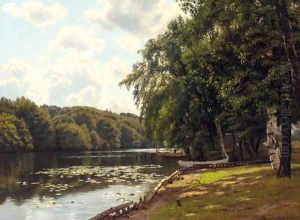Georg Vilhelm Arnold Groth Paintings
Georg Vilhelm Arnold Groth was a Danish painter, primarily known for his landscape paintings. Born on November 11, 1842, in Copenhagen, Denmark, he was a part of the Danish Golden Age of painting, a period when a number of highly skilled painters were active in Denmark.
Groth was educated at the Royal Danish Academy of Fine Arts, where he studied under some of the most prominent artists of the time, such as P.C. Skovgaard and Wilhelm Marstrand. His education at the Academy provided him with a solid foundation in the techniques and styles of the period, which was characterized by a strong focus on realism and nature.
Throughout his career, Groth developed a particular interest in depicting the Danish countryside, creating works that captured the unique light and atmosphere of the region. His paintings often featured rural scenes, coastal landscapes, and agricultural settings. He had a keen eye for the changing seasons and the ways in which light played across different surfaces, a skill that gave his works a sense of immediacy and vibrancy.
Groth exhibited his work at the Charlottenborg Spring Exhibition, an important venue for contemporary Danish artists, and also participated in international exhibitions, gaining recognition outside of Denmark. His works were well-received, and he gradually built a reputation as a skilled landscape painter.
Despite his success, Georg Vilhelm Arnold Groth did not achieve the same level of fame as some of his contemporaries, such as Vilhelm Hammershøi or P.S. Krøyer. Nevertheless, his contributions to Danish art were significant, and his landscape paintings have come to be appreciated for their serene beauty and technical proficiency.
Groth continued to paint throughout his life, and his dedication to his craft is evident in the quality and quantity of his output. He passed away on February 22, 1927, in Copenhagen. Today, his works can be found in Danish museums and collections, where they continue to be admired for their portrayal of the Danish landscape and their place within the broader context of the Danish Golden Age.
